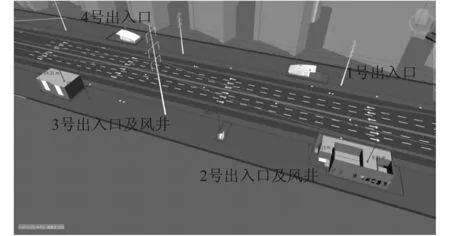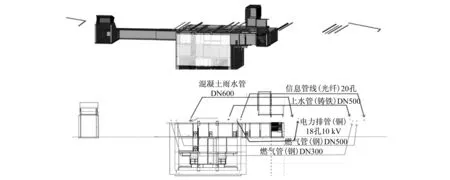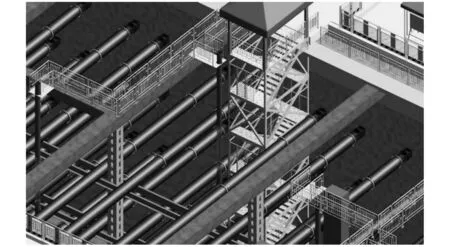建筑信息模型技术在上海轨道交通9号线东延伸工程建设中的应用*
仇兆明
(上海申通地铁集团有限公司,201100,上海∥工程师)
建筑信息模型技术在上海轨道交通9号线东延伸工程建设中的应用*
仇兆明
(上海申通地铁集团有限公司,201100,上海∥工程师)
随着建筑信息模型(BIM)技术在我国民用建筑中的大量应用,城市轨道交通行业也开始引入此项技术。以上海轨道交通9号线东延伸工程为例,介绍了BIM技术在轨道交通建设管理中的应用情况。该技术的应用可使项目建设的成本、进度、质量得到更好的控制,提升了项目的管理效率,对于提高上海轨道交通建设管理水平起到了一定的促进作用。
城市轨道交通;建筑信息模型; 建设管理
Author′s address Shanghai Shentong Metro Group Co.,Ltd.,201103,Shanghai,China
上海市政府在2012年的《政府工作报告》中明确要求“推进智慧城市建设,使信息化更好地惠及市民、服务发展”。作为城市重要基础设施的轨道交通建设和运营是智慧城市建设的重要组成部分。然而轨道交通工程在建设和运营过程中,由于结构复杂多样、需搬迁的市政管线繁多、机电设备系统组成众多且接口复杂,对项目施工方案的制定、施工进度的控制、施工组织协调管理以及后期运营维护带来极大的考验。在后期运营维护过程中,由于建筑、结构、管线、设备等与实际竣工图不一致,施工阶段的相关建筑信息不能准确及时地保存下来,导致维护成本高、效率低。
BIM(建筑信息模型)是以三维数字技术为基础,集成了建筑工程项目各种相关信息的工程数据模型。BIM是对工程项目设施实体与功能特性的数字化表达。一个完善的信息模型,能够连接建筑项目生命周期不同阶段的数据、过程和资源,是对工程对象的完整描述,可被建设项目各参与方普遍使用。BIM具有单一工程数据源,可解决分布式、异构工程数据之间的一致性和全局共享问题,支持建设项目生命周期中动态的工程信息创建、管理和共享。
基于BIM的这些特性,不论是政府还是业内都极其重视BIM的相关研究和应用,而国内外关于BIM技术在轨道交通建设与运维阶段的研究与应用尚处于起步阶段。本文结合上海轨道交通9号线东延伸工程,将BIM应用于项目建设管理的全过程,为今后推广BIM在轨道交通工程建设管理中的应用积累经验。
1 工程建设基本情况
上海轨道交通9号线东延伸工程(以下简为“9号线东延伸工程”)由杨高中路站延伸至曹路站,线路长13.831 km,共有芳甸路站、碧云路站、平度路站、金桥站、申江路站、金海路站、顾唐路站、民雷路站、曹路站等9个车站。这9个站分别由9家施工总承包单位承建,并分别对应9家施工监理单位。
2 BIM应用情况
根据9号线东延伸工程的进展情况以及申通集团关于项目建设管理的相关流程,编制了9号线东延伸工程BIM应用策划书,并以此来规范和指导9号线东延伸工程项目各参建方,以推进BIM技术在工程建设各阶段中的应用。
2.1 BIM协同信息系统
为了提高BIM工作管理效率,专门开发了9号线东延伸工程BIM协同信息系统。这是BIM参与各方信息交互沟通的基础平台,为项目公司和总体设计单位(中铁二院工程集团有限责任公司)的BIM工程项目管理提供技术支撑。该系统可实现项目各BIM参与单位在不同办公地点登录进行工作,且工作成果可通过平台进行交互共享,以实现对项目各参与方、工作任务和BIM成果文件的统一、准确、有效管理,确保项目工作与项目文件的关联性和有效性,最终形成项目电子档案库。该系统功能模块示意图如图1所示。

图1 BIM协同信息系统功能模块示意图
2.2 初步设计阶段
2.2.1 场地现状仿真
学生通过科学的观察与分析更好地对点在运行期间的特征进行了解与掌握,进一步发现函数动点问题中存在的隐藏信息。同时教师应对多媒体教学方法进行运用,结合问题播放相应的动画,对学生问题的回答进行补充并提出较为重要的关键性信息,其中还可结合实际教学情况对学生进行相应的鼓励。其主要目的是对几何画板进行使用,较好地显示出点的运动流程,让学生直观了解其运行流程与运行期间的重中之重。同时许多学生可较好地通过图像发现相应的条件与信息。另一方面,利用对图像进行直接观察还可在一定程度上促进学生学习的积极性。
通过场地现状三维建模,可检查车站主体、出入口和风井与道路红线、绿线、河道蓝线、高压线及周边建筑物之间的距离关系,为规划设计方案送审提供直观的印象。图2为金桥站与周边环境位置关系示意图,图3为金桥站出入口和风井同高压线的位置关系示意图。

图2 金桥站与周边环境位置关系示意图
2.2.2 市政管线搬迁模拟
通过对车站外市政综合管线三维建模,可分阶段模拟管线搬迁并进行碰撞检查,并对管线搬迁方案进行优化。严格按照BIM模型定位进行管线迁改,施工完成后对管线位置进行实测,并对BIM模型进行修正,作为站外市政管线电子档案进行保存,

图3 金桥站出入口和风井同高压线的位置关系示意图
为今后市政管线的运维提供依据。图4为金桥站第一阶段地下管线搬迁示意图。先将车站主体和南侧附属结构范围管线搬迁至车站北侧,以便施工车站主体和南侧附属结构。
2.2.3 道路翻交模拟
通过BIM模型模拟站外交通疏解过程,其周边环境真实直观,可由此检查道路翻交方案的可行性,并对交通方案进行实地优化。
2.3 施工图设计阶段
2.3.1 站内管线综合碰撞检查

图4 金桥站第一阶段地下管线搬迁示意图

图5 金桥站站内综合管线示意图
2.3.2 工程量复核
为配合工程招标,除原投资监理招标工程量计算和设计院施工图预算工程量之外,还可通过BIM三维模型统计招标工程量,并将这三个工程量进行对比,互相校核,以确保招标工程量计算的准确性。此举得了比较好的效果。
2.3.3 装修效果模拟
充分运用BIM技术三维可视化的特征,通过对BIM模型赋予装修材质信息、颜色信息和光源信息,可以模拟场景效果,生成装修效果图。与传统手绘效果图相比,BIM技术生成的效果图修改更方便,颜色更逼真,与实际场景更加切合。图7为金桥站出入口外装修效果图。

图7 金桥站出入口外装修效果图
2.4 施工阶段
利用BIM技术三维可视化的显著特征,可将施工筹划整合到BIM模型中。在正式施工前,先用BIM技术模拟整个施工过程,并以此来检查施工方案的可行性。通过预先施工模拟,可检查各施工工序之间搭接是否紧凑,人工、机械、材料及施工工期安排是否合理,以取得对整个施工筹划进行优化的结果。图8为金海路站基坑开挖示意图。图9为金海路站施工仿真模拟示意图,该仿真模拟是动态的,随着施工过程的推进,施工工程量可同步显示汇总,并能按要求生成验工月报。

图8 金海路站基坑开挖示意图

图9 金海路站施工仿真模拟示意图
3 结语
BIM技术在轨道交通9号线东延伸工程建设
中得到全面应用,使项目建设的成本、进度、质量得到更好的控制,提升了项目的管理效率,对于提高上海轨道交通建设管理水平起到了一定的促进作用。
[1] 黄大明.上海市轨道9号线三期工程可行性研究报告[R].上海:上海轨道交通申松线发展有限公司,2012.
[2] 林敏.上海市轨道9号线东延伸工程BIM应用策划书[R].上海:上海轨道交通申松线发展有限公司,2013.
[3] 蔡蔚.建筑信息模型(BIM)技术在城市轨道项目管理中的应用与探索[J].城市轨道交通研究,2014(4):1.
(Continued from Special Commentary)
The increase of train speeds is the most serious challenge for brake technology. Because the train kinetic energy is proportional to the square of the train speed, under a certain braking distance, the train′s braking power (the kinetic energy transferred by train per unit time) is a cubic function of the train speed. The experiment data showed that even when the train runs at 200 km/h, which just enters the high speed range, if only a single braking mode is adopted (for example, only using the tread brake belonging to the adhesive brake), its average axis braking power would surpass 340 kW limit value. At this time, due to the wheels kinetic energy′s “transferring” and “moving” do not match, the hot cracking of the wheel tread would be led to, which could severely affect the train′s running safety. Therefore, when the high-speed train′s speed grade reaches 350 km/h or more, the best combination of various braking modes must be reasonably selected during the entire period from the starting of the train brake to the train′s complete stop. Among them, the transfer of all or most of the kinetic energy should be undoubtedly completed by various brake modes included in the adhesive brake system according to the period order of the most optimization configuration, so as to reach the high-speed train′s securely-stopping in not beyond the “bottom line” of the adhesive limit and the brake power limit and within the braking distance of that speed grade provided by “The Railway Technology Management Procedures”. Meanwhile, selecting non-adhesive brake modes to share the transfer of part of the train brake kinetic energy must also be considered.
The aerodynamic braking, also known as “the wind drag brake” or “the wing plate brake ”, is a kind of non-adhesive brake. When the train brakes, a certain area of the wing panels (braking wing) on the top of the vehicle body stretches out to increase the total frontal area of the train, so as to increase train running resistance and form part of the braking force. This air resistance is also proportional to the square of train′s running speed, the higher the train′s speed is, the bigger the braking power is. Thus, they have the excellent performance. While the train runs at high speed, due to the wing panels′ making the dramatic changes in the flow field around the train body, mainly on the train body top, they would cause the turbulence phenomenon of the vehicle body surface to be increased, leading to the friction resistance′s between train and air increasing and also forming a certain amount of braking force.
In 2009, the Ministry of Science and Technology and the original Ministry of Railways jointly implemented the joint action plan of the independent innovation of China′s high-speed trains. Among them, the Institute of Railway and Urban Rail Transit of Tongji University undertook the development of the new-type high-speed train braking mode—the aerodynamic braking device (braking wind-wing). It is the first time for China to research this new type of braking system. The project research team underwent 5 years of hard work, and then according to the plan, they installed this braking device prototype that they successfully developed on the experimental train of 500 km/h high-speed that the host plant produced. And from May 9, 2014 to May 15, 2014, the braking device carried out the route test on the upstream section of Yichun to the Nanchang-West of the Shanghai-Kunming railway line. The test results showed that this air resistance braking mode could make more contributions in the train′s high-speed range. When emergency composite braking was implemented at the speed of 350 km/h, the aerodynamic braking device could shorten about 150m braking distance. If the initial velocity (train′s maximum running speed) for braking is higher, this braking system will make a greater contribution in shortening braking distance.
The above-mentioned braking technology of China′s high-speed trains perhaps can be referred to for researching and developing the “super high speed rail” system.
(Translated by SUN Zheng)
Application of BIM in the Construction of East Extension Project on Shanghai Rail Transit Line 9
QIU Zhaoming
BIM technology has been widely applied in civil architectures and urban rail transit industry of China. Taking the east extension project on Shanghai rail transit Line 9 as an example, the application of BIM in the construction management of rail transit is introduced. This technology could help to control the cost, construction schedule and project quality, also improve the project management efficiency. It has played an important promoting role in enhancing the construction management level of Shanghai urban rail transit.
urban rail transit; building information modeling (BIM); construction managementt
*上海申通地铁集团2015科研计划项目(JS-KY152023-5-1)
F 530.7
10.16037/j.1007-869x.2016.06.033
2016-01-20)

